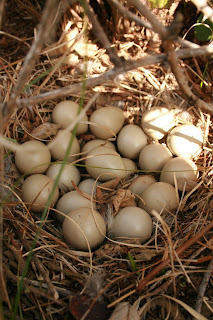
Sitting tight on the nest, the patridge is very well camouflaged amongst the vegetation:

We record all nests using a nest monitoring computer programme and update their progress. So far we have 79 nests logged. At the end of the season, the data will be sent to the BTO. Whilst monitoring nests this year, we have noticed a high level of gull predation. Both Herring and Common Gulls have taken several Oystercatcher and duck eggs. Sadly around 50% of Oystercatcher nests have failed due to predation. Oystercatchers will re-lay a new clutch, but this higher than normal rate of predation suggests gulls are relying on eggs due to a reduction in other food sources, or maybe individual gulls have become specialised to find and take eggs.
Sadly, the Oystercatcher nest containing seven eggs has been predated and is now empty. It's not all bad news however... We recently noted several more Sandwich Terns sitting on the very tip of Far Point that were not present when we conducted our nest count. An additional 326 nests were counted, taking our total number of Sandwich Tern nests up to 4,120. This is the highest ever number recorded on Blakeney Point (previously the highest was in 1992 when there were 4,000).
The very end of May brought several notable migrant birds to the Point. Between the 29th and 31st there were a couple of Wrynecks, a male and a female Red-backed Shrike, several Spotted Flycatchers and a Pied Flycatcher. A nice end to the month. Yesterday morning an Osprey flew over the Lifeboat House.
To finish with, here is a time-lapse video we made of the tide coming in and going out of Pinchen's Creek. Eight hours condensed into ten seconds...
Why are you posting a photo of a bird on the nest, and why a photo of a nest with eggs.
ReplyDeleteWhat is the point? Just leave the bird alone. It doesn't need to be photographed and nothing is gained from it.
We monitor all of the breeding birds on Blakeney Point and record nests as part of the BTO's nest recording scheme. This data is important for understanding bird populations.
DeleteWhen checking nests, taking a quick photograph takes very little time. We hope that such images will be interesting to viewers of the blog and may lead to an increased interest in wildlife conservation. As Rangers on Blakeney Point we are passionate about and committed to protected birds and preventing disturbance, but we also have to carry out important monitoring work which involves getting close to the birds - we are always very careful. I hope this answers your question.